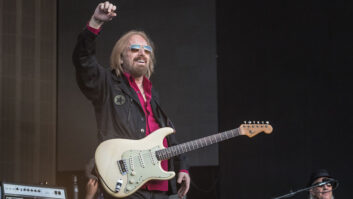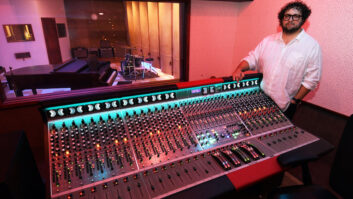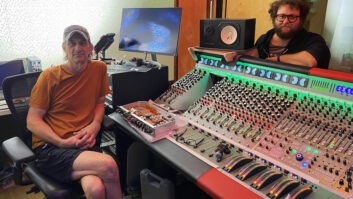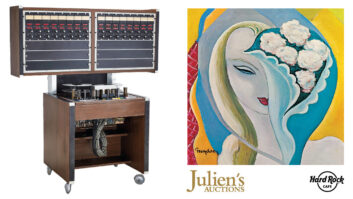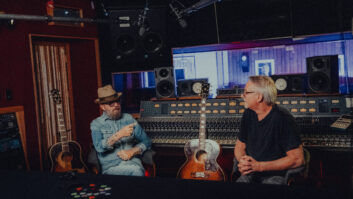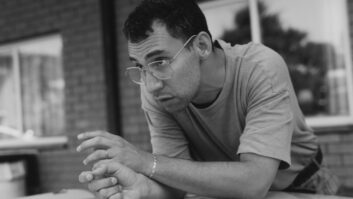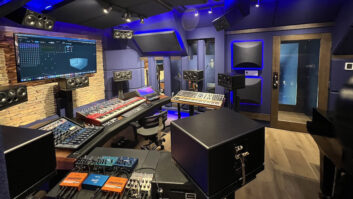Forget the introductory hoo-hah (see last issue). We continue our conversation with recording legend Tom Dowd.
How did Otis Redding strike you?
Oh, he was a pussycat. He was a lover. He was a great human being. I recorded Otis for Stax once or twice on singles, because they were doing them alone themselves. When they were going to do the Otis Blue album, they called me up and said, “Hey, you gotta come down. Otis is only going to be here for two days. We have to do an album.” So we did the album in two days. That was it. Boom. Done. Everything was live, on the fly.
So all the charts were written out and all that by the time you got down?
No. Nobody could read. “Sing me the song. Play me the song.” It was head charts for the horns.
What were the Stax studios like technically? You’d been used to controlling your environment, one could say.
[Laughs.] Hysterical. The first time I ever walked in to Stax Records-this is 1962-they had taken the seats out of an old theater, and that was the studio. Stage-right wing was the control room, with a little window looking into the studio. In the control room was an Ampex 350 mono and two Ampex four-position passive mixers connected in parallel into the mono machine.
We’re talking crude.
Remember, I had been recording four, going on five years on 8-track. And I’d been doing stereo for ten years. And I walk into this and I go, “Gulp!” [Laughs.] But you know what? They were making hit records, so don’t laugh. That’s it; that’s the first thing. Ultimately, I snuck a 2-track machine in on them and fed it to the mono simultaneously so that I could play them back everything in mono. And once or twice I’d play it back to them in stereo, and it was like, “What’s that, man?”
“Hey, it’s coming out of different places!”
Yeah, exactly. These are jovial things, but they were actually quick to adapt.
The first time I got called down there was on a technical problem. They hadn’t been able to deliver us a record for five or six weeks, and they kept on saying, “The equipment’s broken. The equipment’s broken.” And Jerry Wexler said, “Dowd, I don’t trust what they’re doing there. Either they’re not making records, or somebody’s pulling something over. Get your ass down there, and find out what’s wrong.” I got down there on a Friday night-this is the truth-about 7 o’clock Memphis time. I didn’t know [Stax boss] Jim Stewart; he didn’t know me. He picked me up at the airport, drove me to the studio, and I said, “What’s the matter?” and he said, “The Ampex dealer can’t get us this part, and that part is back-ordered.”
I get in the studio, and I look at the machine, and it’s very simple. The brake bands are broken, and the Stop and Start switch doesn’t feel right. I turn the whole thing upside down, look at the electronics, I grab the phone and I call Phil Eihle up in New York and say, “Get me brake bands on a 350, a pair of them, feed and take up. Get me a pile of 68k resistors. Get me this and that.” I’m reading him a list of equipment just looking at this thing upside down. This is standard-we replace these parts in the damn Ampex every six months. And I’m reading this and one thing and another, and I said, “Now when you get all done, call La Guardia airport, and find out when the first plane is to Memphis that you can catch up with. Give a stewardess $25. Give her the brown bag so she can see the parts and not think it’s a bomb, and tell her to page me when she gets in to Memphis, and I’ll give her another $25. Phil calls me next morning, around 11 o’clock Memphis time: “It’s on Eastern Airlines flight so-and-so out of here and the stewardess’s name is whatever the hell…” I said, “Fine.”
Jim Stewart and I go to the airport together, I give this girl $25, she gives me the brown bag, and as we’re going back to the studio, I say to Jim, “Hey, do you have a soldering iron?” Jim says, “I don’t know.” “Do you have long-nosed pliers?” He says, “I don’t know.” “Have you got an electronics store around here?” He says, “Yeah.” I said, “We’re going to spend $15. We went in. We bought a soldering gun; we bought a screwdriver; we bought a nut driver, nickel-and-dime parts. I went into the studio. By now it’s about 2, 2:30 in the afternoon, and the band is practicing. I’d never seen them before.
Which band was this?
This was Booker T and the MGs. And they’re digging. They’d go in and work two, three hours every Saturday afternoon just running tunes down, playing.
So I go in, turn the machine over and I zip-zap here, zip-zap there, I align the machine, I throw on a 7-inch reel, I hit the Record button, and I start recording what the band is rehearsing. Before that night is over, [MGs guitarist] Steve Cropper and I have become bosom buddies, and I’m having ribs at so-and-so’s house and greens at so-and-so’s house, and we’re going to play golf at 7:30 in the morning. So goes that day. About 10:30 the next day, we’re back in the studio, because they want to get down these ideas they have and put them on tape so they don’t forget what they’re doing, and then Rufus Thomas walks in.
“Baby’s back, dressed in black…”
Right. Rufus comes walking in in this suit-fine threads. He’s just coming home from church. And he says, “I was drivin’ down MacLemore [Avenue, where the studio is located] and I see how many cars are in the parking lot, so I figure the studio’s working; somebody’s fixed it.” So I meet Rufus for the first time. And he looks at the band and says, “Hey, I got this ditty. It’ll take two minutes. Let me sing it to you, and then we’ll record it. So I threw a tape on. They run the song down once or twice; I make two passes at it. I play it back to him; he says, “Yeah, that’s fine, man.” He’s going home happy as a pig in a poke.
And that’s “Walkin’ the Dog”?”
That’s “Walkin’ the Dog.” I go up to New York with a tape under my arm the next day, and I finally get to Wexler’s office late in the afternoon, and I say, “Hey, the studio’s flying, they’ll chase you some stuff, and here’s proof-I made this yesterday.” And he listens to it, and he says, “Put the damn thing out!” [Laughs.]
You also worked with Aretha Franklin. She’d done some good music for Columbia but she hadn’t really broken before you worked with her.
I’ve said it before: Aretha cannot sing a bad note. I don’t care what song you give her; she’ll sing her tush off. It’s just a matter of the right time, the right place and the right song. Originally they wanted me to record her in Muscle Shoals, but I just didn’t see recording her in mono only there. So Phil Eihle and I rented a 4-track for ten days or two weeks or something, and escorted it into Muscle Shoals like luggage. Showed up in Rick Hall’s studio and said, “Rick, we’ve got to connect this machine to your console for the Atlantic recordings.” He says, “You’re going to lose my sound!” He’s got nail-polish marks on all the faders: Here’s the bass; here’s the drum; here’s the piano.
What kind of console did they have?
I don’t know. It was a radio console. It was in exquisite condition, I must say, and there was a man who was doing the servicing who was an old radio engineer/transmitter service technician who worked between Muscle Shoals and Memphis. He knew what he was doing.
So Phil and I flipped this console up on its back and looked at it. I think it had six or eight positions. And I’m saying, “Phil, I’m thinking about how I’m going to record. We’re going to make this track her vocal track. We’ll make this track the percussion and bass. We’ll make this track the guitars and organ. No, make the organ with the bass and the piano with the guitars…” What we did was unwire the busing on this console so that we could assign these three faders to track one, this one to track two, and so on. We put the console down, and then we let Rick do one of his own regular sessions on a mono feed. But when Aretha came down, we were ready, and we did her in 4-track. That introduced Muscle Shoals to multitrack.
This is “I Never Loved a Man the Way I Love You”?
Yeah. And then when the sessions ended after like 15 or 20 hours, and everybody was going back to New York, Phil and I had to go back into the studio and unwire what we did and restore every nook and cranny and every piece of dust and restore the console. And then when we got up to New York, we immediately transferred everything to the 8-track machine.
Where was Aretha’s version of “Respect” done?
The Aretha one was done on 60th Street [at Atlantic Studios]. That session flew. We brought part of the Muscle Shoals band up and part of Memphis.
Had the Muscle Shoals and Memphis guys played together much?
They all talked the same language. [Laughs.] They knew each other, and they might gig on a weekend here and there, but no, they never camped together. So that was a slightly unusual choice by you.
Oh, yeah. There’s a videotape out there that’s a 22- or 23-minute tape on yours truly, and there’s an Aretha session cut in there that’s about two-and-a-half minutes long. And if you look in there, you’ll see Roger Hawkins; you’ll see Tommy Cogbill; you’ll see Jimmy Johnson and Eric Gale. Aretha is at the piano. There’ve got to be one or two other musicians but off the top of my head I can’t picture them. And I’m in the control room yelling at them, and they’re not paying attention, and I just busted out of the control room, and I’m walking in among them giving them directions and counting off and singing them parts. But that’s the potpourri of the Muscle Shoals/Memphis rhythm section that we used for the most part on that album.
At one point, when we did the second leg of that album, two days later, I walked in the studio, and I had seven guitar players in there. Joe South heard we were doing her; he wanted to play. As I say, I had Jimmy Johnson, I had Eric Gale, I think Steve Cropper, one or two of the New York guitar players, and in the middle of the session who walks in the control room to see what we’re doing? Eric Clapton! Now what do you do? You look at one, and you say, “We only need one guitar on this,” and then the other six guys are ready to kill you. “Why did you pick him?” And Duane Allman, too. Hello? What do you do now? Once the word got out that we were doing Aretha sessions, after “I Never Loved a Man” came out and we needed an album in a hurry, we had people climbing through the door wanting to play on this session.
You’ve said you always liked to record Aretha while she was playing piano. Why is that? I guess you phrase things differently when you’re playing and singing at the same time.
Yeah, her timing and phrasing shifts when she is standing up as opposed to when she’s sitting down. When she’s playing piano, it’s a lock. When she is standing up, with the facility she has, and hearing what’s going by, she’s singing the same song but the timing is entirely different. The expression is different because she’s not distracted.
Was she involved in her own arrangements at all? Would she have had a hand in the rearrangement of “Respect”?
Oh, yes. She and her sister, who passed away, were always singing each other parts, and then she’d come in the studio and sit down at the piano.
Tell me a little bit about working with the Allman Brothers. People don’t tend to ask you that much about them, but I’ve always thought they were really a great band, and underrated.
That was an adventure. I was supposed to do the Allman Brothers in ’69 or something like that, in New York. As fate would have it, I got dispatched either to Memphis or Los Angeles when I’m supposed to be doing them in New York on their first album. So one of the chaps that was working for me, Adrian Barber, did them. They were on a budget-they had to be in and out in two days, and that was it. And Adrian was not familiar with the Allman Brothers, but he did a helluva job recording, I thought.
You already knew Duane [Allman] from Muscle Shoals…
I knew Duane, but I didn’t know the rest of the band.
For some reason I was in Macon, Georgia, for something, and I went from where I was staying, walking down Broadway toward [Capricorn records chief] Phil Walden’s office, and I hear the sound of this band coming out of this rehearsal room studio. I didn’t walk in; I just heard them playing. And I stood there for about five minutes, and I thought, “Whoever this is, they belong in a studio. They’re wasting time where they are right now. Get them the hell out of there. They swing, they’re blue, and they’re driving, all at once.” To me, it’s three cultures all at the same time. It was wicked. So I get down to Phil’s office, and I said, “By the way, whose facility is that up there?” He said, “That’s our studio.” I said, “Who’s in there now?” And he said, “The Allman Brothers.” I got up and I said, “Phil, send them down to me in Miami tomorrow. Get ready to record. Don’t let them play any more. They’ll lose their edge.” So they came down to Miami like two, three days later, and that’s when we started Idlewild South.
Was that Criteria?
That was Criteria. Ronnie Albert was the engineer, and he was beautiful. He was young and impressionable and as fresh as they were. He didn’t have any inhibitions. He just flew. He said, “I want to do this instead of that.” I said, “Fine. If you think it’ll sound better, do it.” And boom, boom. The band came in, and I think we did three, maybe four songs in two days, and then they had to go back on the road. So we were halfway through an album in one sitting.
Was Criteria all MCI equipment at this point?
Well, Jeep [Harned of MCI] had altered or customized every bit of [Criteria owner] Mack Emerman’s equipment, and brought the Ampexes up to snuff. He didn’t have an MCI tape machine yet. He was still updating Ampexes. And the console was modified by Jeep, whatever the species of it was. Or it might have been the first version that MCI built. I know I did [the Allmans’] Eat a Peach and [Derek & The Dominoes’] Layla on that MCI console.
When you did Derek & The Dominoes, you’d done Cream, so you already had a relationship with Eric Clapton. That was quite a different animal, though, than Derek & The Dominoes. Did you know it was going to be a classic?
We actually did the whole album in ten days-vocals, everything. The only thing that was altered was Eric changed the solo on one song in October, and we added the piano part to “Layla.” But I said when we finished the initial pass at the album, “This is best album I’ve done since Ray Charles’ Genius.” Because that’s the way it hit me. It just killed me. And of course the record didn’t hit for a year. It was like a dead dog. Thank God Atlantic had the patience and the perseverance to stick with it. Because it could have fallen by the wayside. But they stuck with it for a year, and a year later, after “Layla” hit, it became the national anthem. It had to happen. I think by the time it hit I was into the [Allman Brothers’] Fillmore album.
Let me ask you a delicate question about drugs. Obviously there’s lots of cocaine, there’s heroin happening during this era at some sessions…
I will give you my reading on drugs, in spite of Bobby Whitlock, in spite of Eric, in spite of anybody. The Allman Brothers and Derek & The Dominoes-if I denied that they drank, that they used ups and downs, that they smoked, I’d be lying. But when I said, “Two o’clock we’re starting,” then at two o’clock I would have four, five, six, seven people walking in clear-eyed, fresh out of the shower, wanting coffee, and saying, “What are we doing today?”-lucid and clean as a whistle. Every one of them. I don’t know what the hell they did when they weren’t with me-don’t know if they’d been in bed or where they’d been, but at two o’clock they were ready to play.
I think about Coltrane sessions, where Paul Chambers would show up an hour late. One time Philly Joe [Jones] shows up, but he doesn’t have his drums because they’re locked in a club. Another time Elvin [Jones] shows up, and he’s like three feet off the ground. I didn’t have that problem with the musicians that we are talking about now.
Even later, with Clapton, when he was having more problems? Ocean Boulevard and that era?
There wasn’t a drug problem, but there was an alcohol problem. I’ll be honest that there was one time when we were doing something acoustic during-it might have been “Hand Jive,” or something like that, during the 461 album-and Eric was on his second bottle of scotch. I went out there, and I started drinking scotch, and both of us fell asleep on the floor, side by side! Wild, right? Here’s Eric and I on the nod, like, “Hey man, we better stop.” [Laughs.] The alcohol problems that I had on Ocean Boulevard were far worse than any other kind of problems that I had on anything else with the Brothers or with Derek.
You recorded some really key stuff with Rod Stewart. You did six albums, or something?
[Laughs.] The madman. Yeah.
The first time I saw Rod Stewart he was playing tambourine and singing for Jeff Beck. Then it was like ten years later that [Warners president] Joe Smith called me up and said that they were on the verge on signing him from Mercury, and one of the reasons was that he wanted to make records like this and that, and would I record him? And I said, “Of course. It’d be my pleasure.” And that’s a whole other adventure and another series of funny stories.
Generally speaking, he was good to work with?
Oh, yeah. But he was a tough taskmaster.
Were those mainly session guys, as opposed to a band, on those records?
Well, the first two albums that I did with him, Atlantic Crossing and Night on the Town, if you will notice, I used all studio musicians. You will notice David Foster was my piano player. [Laughs.] And the truth of the matter is, in all sincerity, I loathe having to record a group, because I’m limited by the invention or the facility that the group can play. When I was doing Rod’s first albums, you’ll notice I was casting-I’d have this drummer and this bass player on two songs, and then this piano player with this drummer on another. It was like casting a movie. Later on, when his band did their world tour, right after Night on the Town, and it came time to record again, all of a sudden I didn’t have the luxury of calling for this musician or that musician. And if I did, I’d be putting somebody’s nose out of joint. So the production concept changed drastically from the first two albums to the later albums.
Rod Stewart, because of English tax laws and considerations having to do with financing, when he started recording for Warner, his advisers said they didn’t want him to say the songs were written in England, because then they’d be subject to tax. And they didn’t want to record them here because blah, blah, blah. So we’re doing the tracks here, the vocals there, and he’d write a song when he was on a plane. They found every way to evade pinpointing where the songs were done.
At one point, the situation was: Everything is fine, but we can’t do the vocals here because we did the tracks here. This is some of the stuff I did in Memphis or in Los Angeles. So the endeavor is we zap up to Toronto to put the vocals on. We’re up in Toronto about two days, and in the middle of the second day in the studio working on a vocal and out of a clear blue sky, Rod lifts the earphones off, he says, “I can’t sing in this place. I can’t stand this city. I want out of here.” He goes storming out of the studio. And he was singing well. I thought, “Oh, boy, what do I do now?” Because we had shipped the tapes into Canada, through customs, I now have to make certain that everything is packed the same way, stored in the same boxes, so that I can get it back out of the country and not have it held by Canadian or American authorities.
And Rod comes busting back into the studio about a half-hour later. He says, “When are we going to leave?” Now he’s really uptight. And I described to him, “Rod, I have a problem. Because we brought these things into the country, we have to ship them out in exactly the same cases, the inventory lists have to read the same, otherwise we’ll have…” And he has no patience with this. “I’ll wait in the car.” Finally, I get out into the car, and he’s sitting there with his notebook, and he says, “Take this song down.” I look at him, and I say, “I don’t have my recorder.” Well, I had a stream of expletives go by that only an English soccer fan could have used. He was livid. And I said, “Sing me the song.” And he says, “What for?” And I said, “Sing me the song.” So he starts singing this verse, and he sings me this chorus that he’s written, and I have a piece of manuscript, and I am scribbling down what he has written, as he’s singing it. And I say, “Sing it one more time, and then stop.” He sings it one more time, and I say, “Okay, now what’s the verse go like?” And he says, “Well, I haven’t finished the verse, but it goes ‘la-de-da.'” And I’m thinking, “I don’t want to make him self-conscious. He just changed keys on me. I won’t say anything.”
We get all the way back to Los Angeles, and Night on the Town becomes a monstrous hit. He goes on the road. Comes back from being on the road, and calls me up one day in Miami, and he says, “Mate, how would you like to record next week? I’m ready to record.” I said, “Fine.” I get out to Los Angeles, and he plays me one or two songs that the band has worked up. We start to record, and about halfway through the first date he looks at me, and he says, “Knock it on the head.” I said, “What do you mean?” He says, “It doesn’t sound good. It sounds terrible.” And I said, “Rod, it’s going to cost us money. We’ve booked the studio, and we’ve contracted the musicians for two sessions a day for the next three days, and whether we record or not, we have to pay them.” Well, now there’s another series of expletives; here we go. I said, “Look, we have to find something to do.” So we’re going back through old songs and notes that I have in this shoulder bag. And I come up with this piece of manuscript, and I say, “Wait a minute! Do you remember you played me this thing? You sang me this song.” And I start to play him like two bars of it. He says, “Give the band a lunch break. I’ll be back in an hour.” And that was “You’re in My Heart.” I still have the original manuscript where I scribbled down his nutty singings when we were in Toronto. At his last wedding, I toted along the manuscript, and Rod scribbled on the bottom of it, “Mad shoutings from a Toronto car park.”
You always liked tracking live. Was it a hard adjustment going from recording that way to the more piecemeal method that was more prevalent in the mid- and late ’70s? Even the sound of studios changed in the ’70s.
I adjust to what the artist feels is the most comfortable. If I have my druthers, I will record as many musicians simultaneously as I possibly can. Because I want the breathing. I want the interaction. Even if the vocal I’m taking is never going to be the final vocal, I would like the vocalist to sing while the band is playing, so if there’s an inflection, if there’s an ad-lib, the band responds to it. Because I can’t build that response in; I can’t invent it. So I am more inclined to enjoy live recording of as many people in the band at one time as I can possibly get.
It seems, though, it’s sort of swung back that way a little bit now.
The thing that really cooked it or cured it for me was the Allman Brothers, when we put them back together again for the umpteenth time [a few years ago].
Those are some really good records. I like Seven Turns a lot.
The first one we did was very, very tough. We were tracking and then adding a solo, then adding this, adding that; it was an overdub special. It was designed that way, it took a lot of time, and it came off that way. But when it came time to do the next album, I said to them, “I would love to go back to recording like we used to. Where I have five, six of you guys in the studio at one time, and we record.” Well, that’s when [drummer] Butch Trucks and [manager] Bert Holman came up with their idea of recording at Burt Reynolds’ barn up in Jupiter, Florida. And we set the band up in the barn as if they were on stage-foot monitors, no P.A. feed, and a riser with the drums up high. And we rented a truck and pulled it up outside the barn. Rehearse two or three songs-boom-hey, that’s ready to record. Record it, and the only thing we’re overdubbing is either the vocal or the solo. Everything else is live as they flew by on that one pass.
Do you get the same thrill in the studio that you did 50 years ago?
Oh, yeah. It’s still a rush. Something goes by, and you go, “Wow.” You get a glow, and you think, “Hey, I’m lucky I’m here.”
